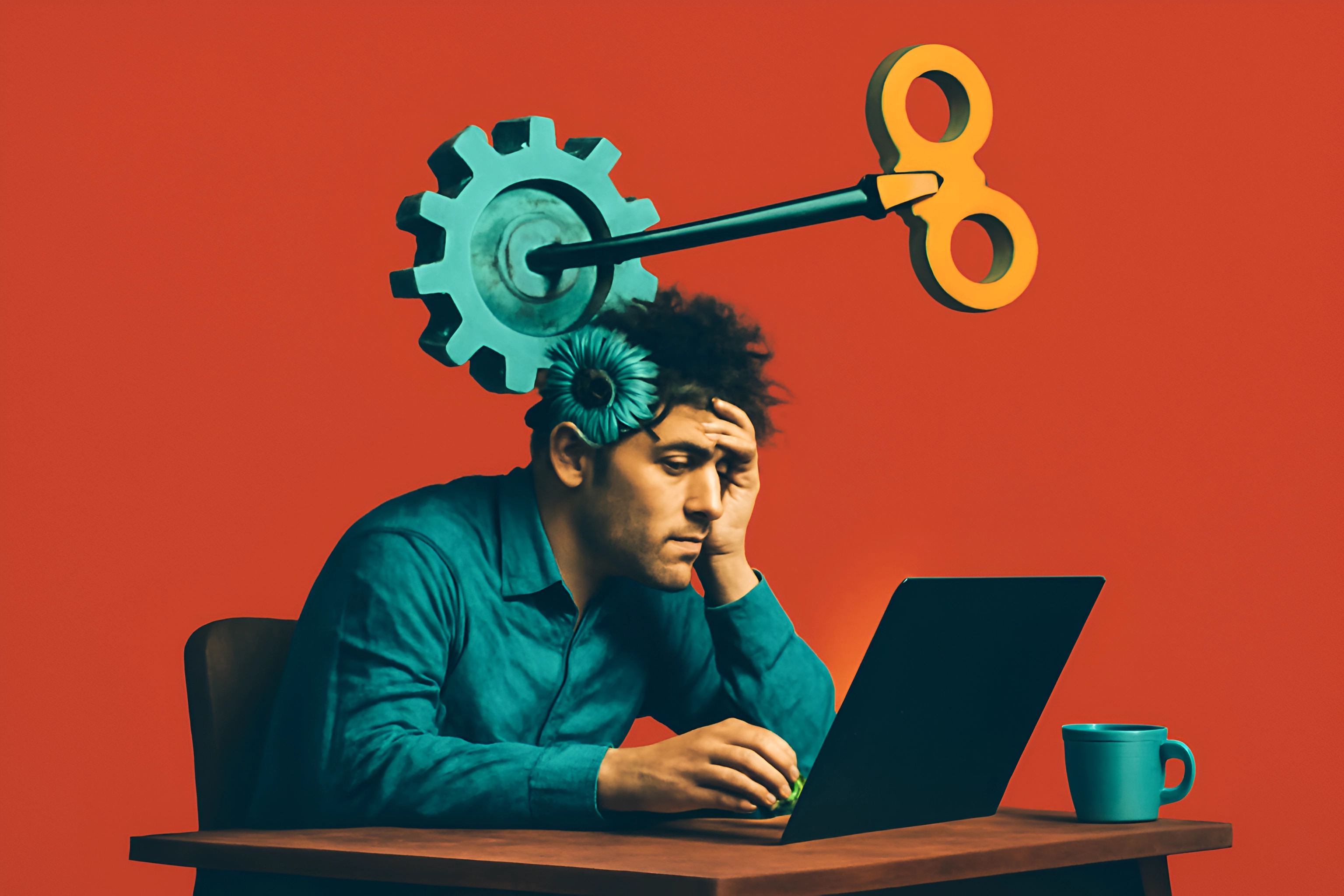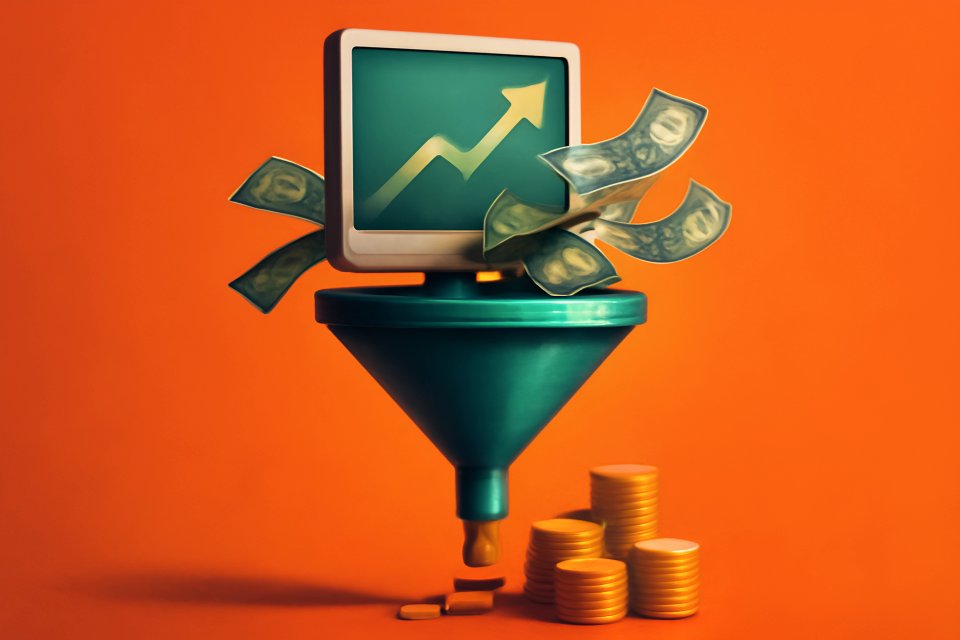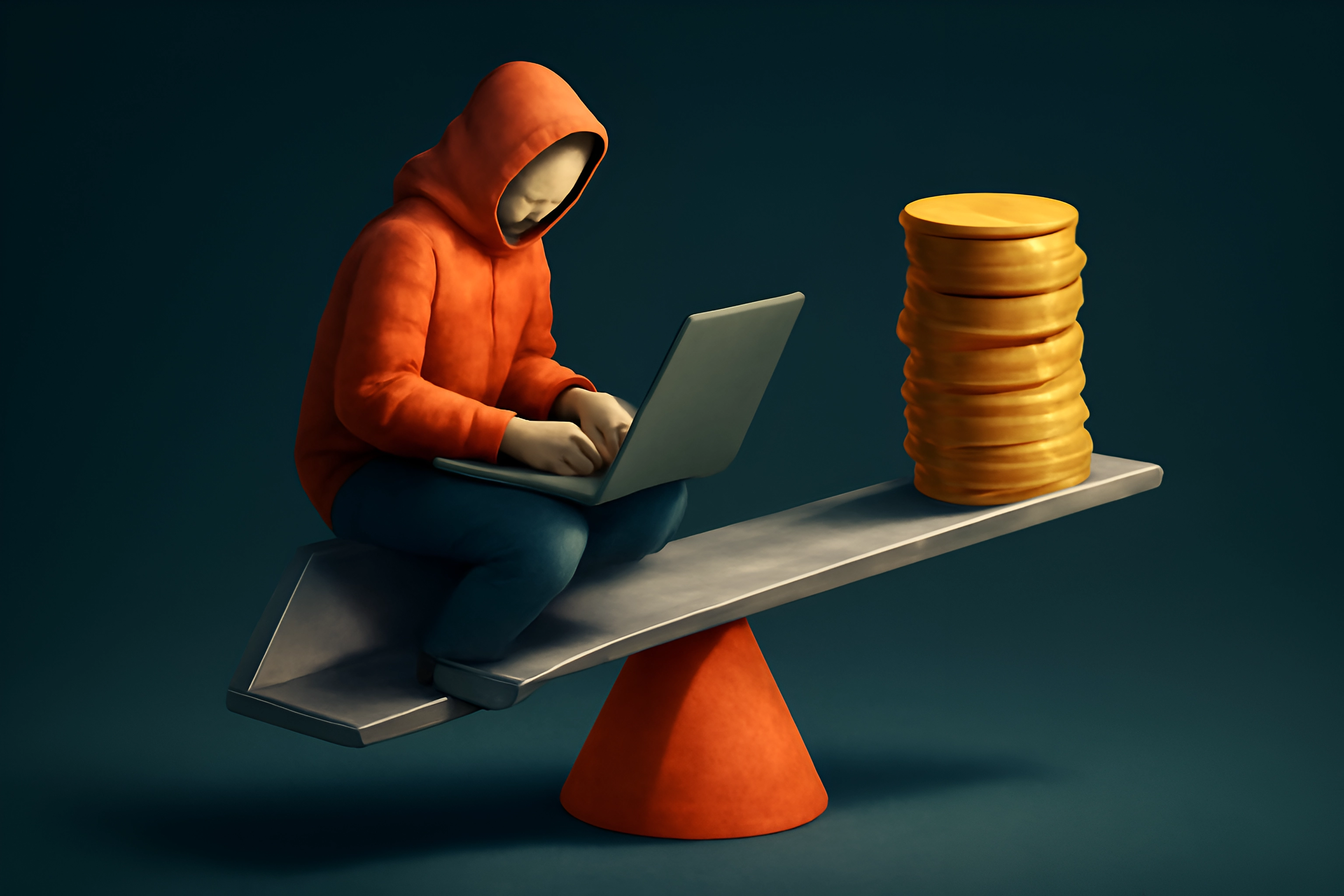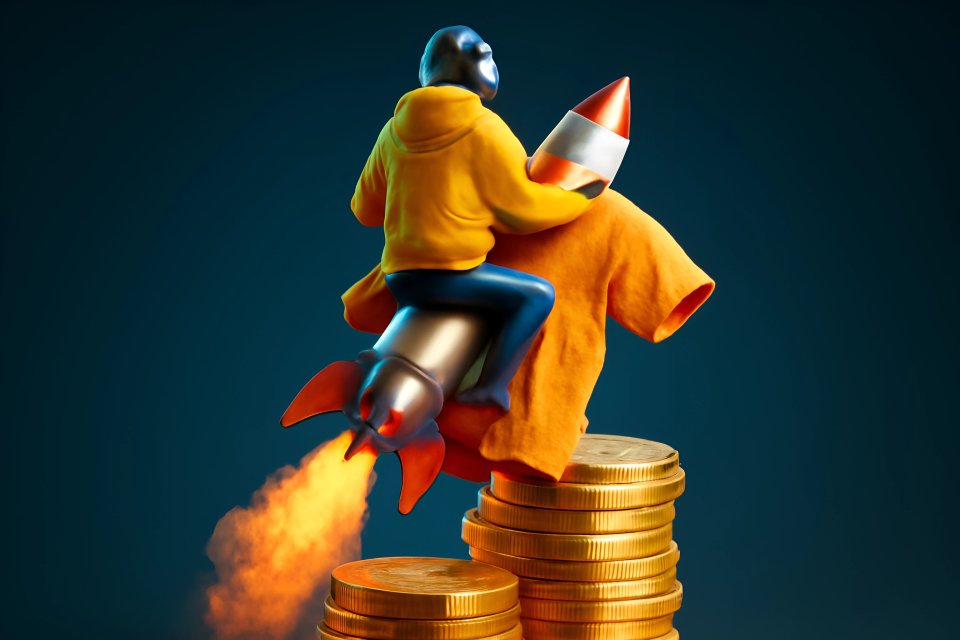
Is this you? It’s 11 PM, and the only light in the room is the cold, blue glow of your laptop screen. Your to-do list seems to have more in common with a fantasy novel than a daily plan, and a wave of exhaustion washes over you. You’re working harder than ever, pouring your soul into this digital dream, but you feel like you’re running in place. This is the unspoken cost of the hustle, the quiet reality for countless digital entrepreneurs fighting to make their mark.
This feeling isn't just being tired. It's digital entrepreneur burnout, a state of chronic physical and emotional exhaustion that the World Health Organization now classifies as a legitimate occupational phenomenon. It’s the thief that steals your creativity, drains your motivation, and puts your entire business at risk. While productivity apps and time-management hacks offer a temporary fix, they’re like putting a bandage on a broken bone—they treat the symptom, not the cause.
The real, sustainable solution lies deeper. It’s about rewiring the very way you think about your work, your success, and yourself. This is where you take back control. By the end of this article, you will have a clear, actionable framework built on powerful mindset shifts to overcome digital entrepreneur burnout. You’ll learn how to protect your most valuable asset—your energy—and build a digital career that is not only productive but truly sustainable.
Why Burnout is the Digital Entrepreneur's Shadow
If you feel like you’re on the fast track to burnout, you’re not alone, and it’s not a personal failing. The very nature of digital entrepreneurship creates a perfect storm for exhaustion. We operate in a world designed to drain us, and understanding why is the first step toward fighting back.
The "Always-On" Pressure Cooker
The digital world never sleeps, and it demands you don't either. There's a relentless pressure to create content, post updates, reply to comments, and engage with your audience across a dozen platforms, 24/7. This "always-on" culture creates a state of hyper-vigilance, where your brain never truly gets to switch off, leading to what experts call technostress.
This constant digital engagement isn't just mentally taxing; it's a significant driver of burnout. Studies show that a staggering 82% of remote workers experience symptoms of digital burnout, a condition marked by exhaustion and cynicism from prolonged screen time. Your business depends on your digital presence, but that same presence can become a prison if not managed with intention.
The expectation for immediate response and constant availability turns your passion project into a high-pressure job with the world's most demanding boss: the algorithm. This pressure cooker environment is a primary reason why so many passionate entrepreneurs find their fire extinguished, replaced by a deep sense of fatigue and detachment. It’s a battle for your attention, and without a strategy, you are guaranteed to lose.
The Isolation of the Solopreneur
In a traditional job, you have a team. You have colleagues to bounce ideas off of, a manager for guidance, and a built-in social structure that provides support. As a digital entrepreneur, who do you have? Often, the answer is just yourself, and that isolation is a heavy burden to carry.
There is no clear "off" switch when your office is your living room and your commute is ten steps to your desk. This lack of separation, combined with the absence of a supportive team, means you bear the entire mental load of your business alone. Research highlights that this isolation is a key vulnerability, making it one of the most challenging aspects of entrepreneurship compared to traditional employment.
This solitude amplifies every setback and minimizes every win. A failed launch feels catastrophic when there's no one to tell you it's okay, and a small victory feels hollow when there's no one to celebrate with. This emotional vacuum is a breeding ground for the negative thought patterns that fuel burnout, making community not just a nice-to-have, but a crucial tool for survival.
The Weight of Wearing All the Hats
As a digital entrepreneur, you are the CEO, the marketer, the content creator, the accountant, and the customer support agent. You are the entire C-suite and the intern, all wrapped into one. While this autonomy is empowering, it comes at a steep cognitive cost.
Juggling these disparate roles leads to a state of constant context-switching and decision fatigue. Every day is a barrage of choices, from high-level strategy to the color of a button on your website. This relentless demand on your executive function is a direct path to overwhelm and is a core reason why entrepreneurs face unique burnout risks.
Your brain isn't designed to be an expert in everything simultaneously. When you force it to be, you deplete your mental energy reserves far faster than someone in a specialized role. This is why so many entrepreneurs feel perpetually busy but unproductive; their energy is being spent on switching hats, not on moving the needle.
The 5 Core Mindset Shifts to Reclaim Your Energy and Focus
To truly conquer burnout, you must change the game, not just play it harder. The following five shifts are about fundamentally altering your internal operating system. This is how you move from being a victim of your business to being the architect of your success.
| From (Burnout Mindset) | To (Sustainable Mindset) |
|---|---|
| "Hustle at All Costs" | "Sustainable Systems" |
| "Perfectionism" | "Progress Over Perfection" |
| "Comparison and Competition" | "Community and Collaboration" |
| "Failure as an Endpoint" | "Failure as Data" |
| "Work-Life Balance" | "Intentional Work-Life Boundaries" |
1. From "Hustle at All Costs" to "Sustainable Systems"
The digital world glorifies the grind. We're told that success requires sleepless nights and sacrificing everything for the "hustle." This is a dangerous lie. Believing that more hours worked automatically equals more success is the fastest way to burn your passion, your energy, and your business to the ground.
The mindset shift is to stop worshiping effort and start worshiping efficiency. Your goal is not to be the busiest person you know; it's to build smart, repeatable systems that generate results without requiring your constant, brute-force effort. This is about leverage, not labor. You need to find the essential digital tools for solopreneurs that automate and streamline your workflow, freeing you to focus on what truly matters.
A powerful way to start is by applying the 80/20 principle, also known as the Pareto Principle. Research shows this isn't just a theory; it's a practical tool for focusing effort where it counts. Take a hard look at your weekly tasks and ask: what is the 20% of my activity that is generating 80% of my results? Once you identify it, you can ruthlessly prioritize those high-impact actions and begin to build efficient productivity systems around them.
2. From "Perfectionism" to "Progress Over Perfection"
Are you stuck? Have you been tweaking that blog post for three weeks? Are you endlessly refining your sales page, terrified to hit "publish"? This is perfectionism, and it's not a badge of honor—it's a cage. It’s a fear of judgment disguised as high standards, and it is the ultimate killer of momentum.
The shift is to embrace the concept of "progress over perfection." It is infinitely better to launch something at 80% perfect and get real-world feedback than to keep a "perfect" project on your hard drive forever. This approach, central to methodologies like The Lean Startup, is about learning and iterating quickly. Adopting this mindset is crucial for launching a profitable side hustle on a budget without getting bogged down.
Here’s your actionable tip: set a "good enough" deadline. For your next project, determine a reasonable endpoint and when the timer goes off, you ship it. No more tweaks, no more second-guessing. This practice builds the muscle of consistent action, which is far more valuable than the illusion of perfection.
3. From "Comparison and Competition" to "Community and Collaboration"
The endless scroll through social media can be toxic. You see someone else's perfectly curated success—their launch numbers, their follower count, their flawless lifestyle—and you compare it to your messy, behind-the-scenes reality. This comparison trap is a direct pipeline to imposter syndrome and feelings of inadequacy.
The mindset shift is to see your peers not as competitors, but as a potential community. Another person's success does not diminish your own potential; there is enough sun for everyone to shine. Focus on your own unique journey and measure your progress against only one person: who you were yesterday.
To make this tangible, create a "Win Jar" or a simple digital document. At the end of each week, write down every single achievement, no matter how small—you landed a new client, you published a post, you finally cleaned your desk. When you feel the poison of comparison creeping in, open that jar and review your own, real progress. This simple act reframes your focus from external validation to internal accomplishment.
4. From "Failure as an Endpoint" to "Failure as Data"
A failed product launch. A blog post that gets zero traffic. A proposal that gets rejected. For many entrepreneurs, these moments feel like a final verdict on their worth, a sign that they should just give up. This is a critical factor in overcoming side hustle burnout, because side hustles are filled with these small "failures."
The most resilient entrepreneurs reframe every failure as a data point. It is not a reflection of you; it is simply valuable information. A failed launch tells you what your audience doesn't want. A low-traffic article tells you your headline or distribution strategy needs work. As one founder noted, these moments provide critical lessons for entrepreneurs.
Your actionable tip is to conduct a "post-mortem" after every perceived failure. Don't just wallow; analyze. Ask yourself three simple questions: 1. What was my hypothesis? 2. What were the actual results? 3. What are 3 concrete lessons I can apply to my next attempt? This transforms a painful event into a powerful education.
5. From "Work-Life Balance" to "Intentional Work-Life Boundaries"
The idea of a perfect 50/50 "work-life balance" is a myth, especially for entrepreneurs. Chasing this unattainable ideal only leads to guilt and a sense of failure when work inevitably bleeds into your personal time. The very nature of building something from scratch requires periods of intense focus that don't fit neatly into a 9-to-5 box.
Instead of "balance," strive for "intentional boundaries." This isn't about a perfect split; it's about you being in control. You consciously decide when you are "on" and when you are "off," and you protect that "off" time with the same ferocity you apply to a critical business deadline. This is about recharging your digital stamina so you can show up fully when it matters.
Implement a "Digital Sunset." This is a non-negotiable time each evening—say, 8 PM—when all work-related devices are shut down and notifications are silenced. This practice of creating a hard stop has been shown to be incredibly effective. An electronic sunset creates the psychological space needed for genuine rest and recovery, ensuring you don't just stop working but actually start resting.
Your Anti-Burnout Toolkit: Putting Mindset into Practice
Knowing these shifts is one thing; living them is another. True change happens when you build these new mindsets into your daily and weekly routines. Here are three simple, powerful practices to get you started.
The 5-Minute Weekly Mindset Reset
Dedicate five minutes every Sunday to consciously set your intention for the week. This isn't about planning tasks; it's about programming your mindset. This simple 5-minute reset can anchor your entire week in a more sustainable approach.
Your reset has three parts. First, review your "Win Jar" or progress document to remind yourself of how far you've come. Second, choose one of the five mindset shifts to be your primary focus for the week ahead. Third, identify and schedule one completely non-work-related activity that you will protect at all costs.
This simple ritual shifts your focus from a reactive state of putting out fires to a proactive state of intentional growth. It ensures that your well-being and mental health are not afterthoughts but are planned priorities, just like your most important business meetings.
Time Blocking for Deep Work and Deep Rest
Your calendar is your most powerful tool for protecting your energy. Stop using a simple to-do list and start time blocking. This method, popularized by experts like Cal Newport, involves scheduling every part of your day, and it's one of the most effective strategies for deep work.
Schedule focused, 90-minute blocks for your most important, high-cognition tasks. During these blocks, turn off all notifications and eliminate distractions. But here is the critical part: you must also schedule your breaks and rest periods with the same level of importance. Block out time for a walk, a hobby, or even 20 minutes of doing absolutely nothing.
When rest is on your calendar, it becomes a commitment rather than something you'll "get to if you have time." This practice ensures you are managing your energy, not just your time. It respects the biological reality that your brain needs cycles of intense focus followed by genuine recovery to perform at its peak.
Find Your People
You cannot and should not do this alone. Isolation is a massive contributor to burnout, and community is the antidote. Actively seeking out a supportive network is one of the most effective digital entrepreneur burnout solutions available.
This doesn't have to be a formal, expensive group. It can be a small mastermind of 3-4 fellow entrepreneurs who meet virtually every two weeks to share wins, challenges, and hold each other accountable. It can be an online community dedicated to positive growth. The key is to find people who understand the unique pressures of your journey.
Make it a goal this month to connect with one other "Earnist." Reach out to someone you admire and ask for a 15-minute virtual coffee. Sharing the journey, even with just one other person, can dramatically reduce the mental load and remind you that you are part of something bigger than just your own struggle.
Conclusion: Earning Smarter Starts in Your Head
Let's be clear: burnout is not a badge of honor. It is not a prerequisite for success. It is a warning sign from your body and mind that your current approach is unsustainable and needs to change. The path to building real, lasting financial freedom is a marathon, not a sprint, and a healthy, resilient mindset is the only way you'll ever finish the race.
The five shifts—from hustle to systems, perfectionism to progress, comparison to community, failure as an endpoint to failure as data, and balance to boundaries—are your new foundation. They are the internal architecture for a business that energizes you instead of draining you. They are the difference between building a prison of your own making and building a platform for your freedom.
You are in control. You have the power to redefine your relationship with your work, to protect your energy, and to build a business on your own terms. It all starts not with a new app or a new hack, but with a conscious decision to change your mind.
The most powerful productivity tool you have is a well-rested, focused, and resilient mind.
What's one mindset shift you're committed to trying this week? Share your goal in the comments below—declaring it is the first step to making it real.














